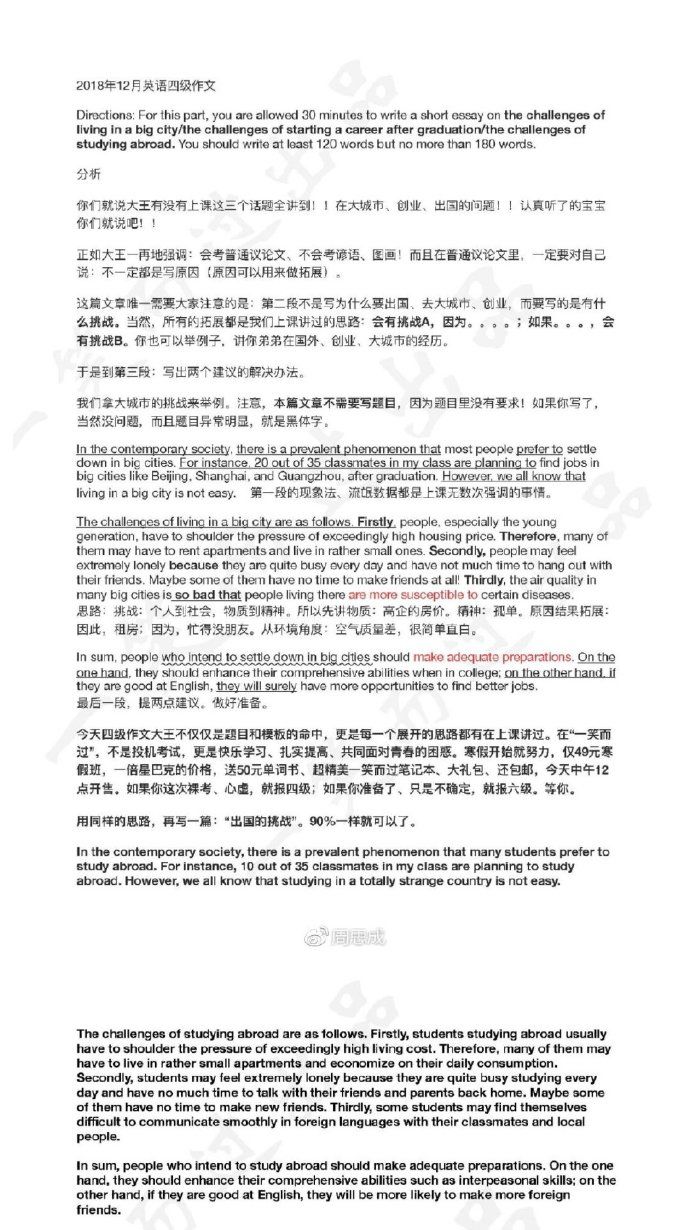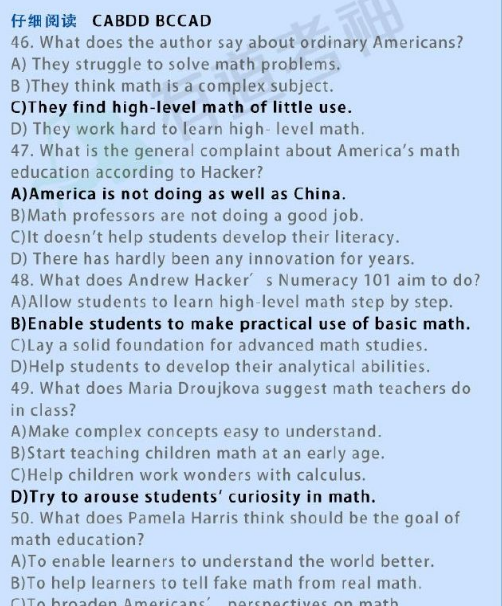LSAT模拟试题:LSAT模拟试题TEST6逻辑3d
|
Questions 16-17 G: The group of works exhibited in this year's Metropolitan Art Show reveals a bias in favor of photographers. Equal numbers of photographers, sculptors, and painters submitted works that met the traditional criteria for the show, yet more photographs were exhibited than either sculptures or paintings. As you know, each artist was allowed to submit work in one medium only. H: How could there have been bias? All submitted works that met the traditional criteria-and only those works-were exhibited in the show. 16. If both G's assertions and H's assertion are true, which one of the following must also be true? (A) More photographers than sculptors or painters submitted works to be considered for exhibition in the Metropolitan Art Show. (B) All the works submitted for the Metropolitan Art Show met the traditional criteria for the show. (C) The quality of photographs exhibited in the metropolitan Art Show was inferior to the quality of the sculptures or paintings exhibited. (D) Some of the photographs submitted for the Metropolitan Art Show did not meet the traditional criteria for the show. (E) More works that met the traditional criteria for the Metropolitan Art Show were submitted by photographers than by sculptors or painters. 17. Which one of the following, if true, most strongly supports G's allegation of bias? (A) If an artist has had one of his or her works exhibited in the Metropolitan Art Show, that artist has an advantage in getting commissions and selling works over artists who have never had a work exhibited in the show. (B) The fee for entering photographs in the Metropolitan Art Show was $25 per work submitted, while the fee for each painting or sculpture submitted was $75. (C) The committee that selected from the submitted works the ones to be exhibited in this year's Metropolitan Art Show had four members: one photographer, on sculptor, one painter, and one who works in all three media but is the least known of the four members. (D) Reviews of this year's Metropolitan Art Show that appeared in major newspapers and magazines tended to give more coverage to the photographs in the show than to the sculptures and paintings that were exhibited. (E) in previous years, it has often happened that more paintings or more sculptures were exhibited in the Metropolitan Art Show than photographs, even though the total number of works exhibited each year does not vary widely. Questions 18-19 Marcus: For most ethical dilemmas the journalist is likely to face, traditional journalistic ethics is clear, adequate, and essentially correct. For example, when journalists have uncovered newsworthy information, they should go to press with it as soon as possible. No delay motivated by the journalists' personal or professional interests is permissible. Anita: Well, Marcus, of course interesting and important information should be brought before the public-that is a journalist's job. But in the typical case, where a journalist has some information but is in a quandary about whether it is yet important or “newsworthy,” this guidance is inadequate. 18. The point made by Anita's statements is most accurately expressed by which one of the following? (A) Marcus's claim that traditional journalistic ethics is clear for most ethical dilemmas in journalism is incorrect. (B) The ethical principle that Marcus cites does not help the journalist in a typical kind of situation in which a decision needs to be made. (C) The ethical principle that Marcus cites does not help the journalist in a typical hind of situation in which a decision needs to be made. (D) There are common situations in which a journalist must make a decision and in which no principle of journalistic ethics can be of help. (E) Traditional journalistic ethics amounts to no more than an unnecessarily convoluted description of the journalist's job. 19. In order to conclude properly from Anita's statements that Marcus' general claim about traditional journalistic ethics is incorrect, if would have to be assumed that (A) whether a piece of information is or is not newsworthy can raise ethical dilemmas for journalists. (B) there are circumstances in which it would be ethically wrong for a journalist to go to press with legitimately acquired, newsworthy information. (C) the most serious professional dilemmas that a journalist is likely to face are not ethical dilemmas (D) there are no ethical dilemmas that a journalist is likely to face that would not be conclusively resolved by an adequate system of journalistic ethics (E) For a system of journalistic ethics to be adequate it must be able to provide guidance in every case in which a journalist must make a professional decision Questions 20-21 Of every 100 burglar alarms police answer, 99 are false alarms. This situation causes an enormous and dangerous drain on increasingly scarce public resources. Each false alarm wastes an average of 45 minutes of police time. As a result police are consistently taken away from responding to other legitimate calls for service, and a disproportionate share of police service goes to alarm system users, who are mostly businesses and affluent homeowners. However, burglar alarm systems, unlike car alarm systems, are effective in deterring burglaries, so the only acceptable solution is to fine burglar alarm system owners the cost of 45 minutes of police time for each false alarm their systems generate. 20. The statement that burglar alarm systems, unlike car alarm systems, are effective in deterring burglaries plays which one of the following roles in the argument? (A) It justifies placing more restrictions on owners of burglar alarms than on owners of car alarms. (B) It provides background information needed to make plausible the claim that the number of burglar alarms police are called on to answer is great enough to be a drain on public resources. (C) It provides a basis for excluding as unacceptable one obvious alternative to the proposal of fining owners of burglar alarm systems for false alarms. (D) It gives a reason why police might be more inclined to respond to burglar alarms than to car alarms. (E) It explains why a disproportionate number of the burglar alarms responded to by police come from alarm systems owned by businesses. |








